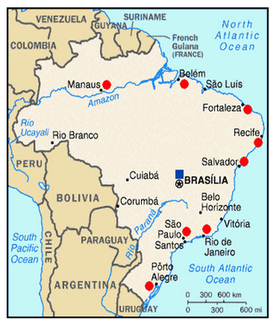
Okay everybody,
My sailing days in the Carribean over, I raced through Venezuela to get into Brasil, crossing the border in the south east (at Santa Elena) and went straight on into Manaus, which is the gateway into the Amazone forest. Took a jungle tour there and since this kind of experience is hard to describe in words, thought I´d take the time to put it in a little presentation, allthough it is going to cost me a fortune in cybertime...
Hope you´ll enjoy it, it isn´t very long.
Salut les gars et filles,
Etant donne que mes jours sur la mer etaient termines, j´ai traverse la Venezuela a du 100 a l´heure (voyage de bus de 36 heures, merci), pour traverser la frontiere avec le Bresil et me rendre a Manaus, qui est la porte pour l´Amazonie. La, j´ai eu le plaisir de faire un petit tour du jungle, ce qui est une experience difficile a decrire, donc j´ai pris le temps de faire un tout petit presentation (vous savez comme je les adore ;-)
J´espere que ca va vous plaire, portez vous bien!
Dag menskes,
Oke, gezien mijn schipperdagen over waren in de Caribische zee, in zeven haasten door Venezuela gecrost, om daar de grens in het zuidoosten met Brazilie over te steken (36 uur bus, dankjewel), en aan te komen in Manaus, dat de toegang is tot het Amazone woud in Brazilie. En wie zouden we zijn moesten we daar niet even binnenspringen? Maar aangezien het een ervaring is die moeilijk in woorden te vatten is, heb ik de vrijheid genomen jullie een kleine presentatie te maken (sommigen van jullie weten hoe fel ik daar een fan van ben). Sorry hoor maar vind het gewoon gemakkelijker...
Hoop dat jullie het tof gaan vinden, al mijn beste wensen in elk geval ginds in het koudere belgenland, en tot schrijfs...
Hola querid@s,
Despues de terminar a mis dias con los veleros en el Caraibe, pasaba por Venezuelka con mucho velocidad (36 horas de bus, gracias) para entrar en Bresil y llegar en Manaus, la entrada de bosque de la Amazonie. Acqui he hecho un passeo por el bosque y, con el hecho que es bastante dificil a describir en palabras, lo he hecho dentro de un pequeno presentacion powerpoint, que esta anadido. Espero que lo disfrutan!
The rain forest in Brasil and Manaus
1, Where am I?
Manaus, capital of the state of Amazonas, is the largest state in Brazil. It is also the ideal point of departure for visiting the rest of the Amazon region. Tour boats leave Manaus to see the Meeting of the Waters, where the black waters of the Negro River meet the brown waters of the Solimoes River, flowing side by side without mixing for several miles.
2, Manaus, the city
It had a big boom with rubber trees about a hundred years ago, with big buildings like their opera house (with a rubber road leading up to it so late comers wouldn´t make too much noise!), so people called it the Paris of the south. With the seeds being exported to Asia, has declined and is now mainly living off amazon tourism, and free trade zones.
4, Jungle tour
So, being in the amazon and all, decided to go on a jungle tour to the forest, with Ecoplanet (run by a Belgian, yes yes, we are everywhere) who has a lodge at Mamori lake.
5, Un poco de informacion sobre la celda:
Cortada por la línea del Ecuador, la Amazonia abarca una gran extensión del territorio brasileño y parte de los países limítrofes del Norte y Noroeste de Brasil: Guayana Francesa, Suriname, Guayana, Venezuela, Colombia, Ecuador y Perú.La región está cubierta por selva tropical húmeda, que con sus 5,5 millones de Km2 es la mayor del planeta y la más rica en biodiversidad.
En una área de 2 Km2 se llegan a encontrar 300 tipos de especies vegetales diferentes, existiendo también gran variedad de animales, principalmente insectos, aves y primates. Se han clasificado más de 1000 especies de peces diferentes, casi la misma cantidad que en el Océano Pacífico.
El suelo de esta región no sirve para explotaciones agrícolas ni pecuarias porque una vez derribada la selva, el suelo pierde rápidamente su fertilidad. Tiene amplios recursos minerales pero su explotación es precaria debido a la dificultad del medio y a la falta de infraestructuras, por lo que su principal actividad económica es la explotación forestal, especies y madera, calculándose que son cortados más de medio millón de árboles todos los años.

No comments:
Post a Comment